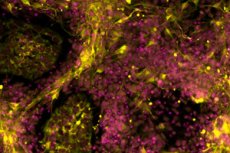Stem cells shed light on genetic mechanism of childhood cancer
Sist anmeldt: 14.06.2024

Alt iLive-innhold blir gjennomgått med medisin eller faktisk kontrollert for å sikre så mye faktuell nøyaktighet som mulig.
Vi har strenge retningslinjer for innkjøp og kun kobling til anerkjente medieområder, akademiske forskningsinstitusjoner og, når det er mulig, medisinsk peer-evaluerte studier. Merk at tallene i parenteser ([1], [2], etc.) er klikkbare koblinger til disse studiene.
Hvis du føler at noe av innholdet vårt er unøyaktig, utdatert eller ellers tvilsomt, velg det og trykk Ctrl + Enter.

Scientists have made a new discovery in the genetic pathways of childhood cancer, opening up new prospects for personalised treatments.
Researchers at the University of Sheffield have created a stem cell model to study the origins of neuroblastoma, a cancer that mainly affects infants and young children.
Neuroblastoma is the most common childhood cancer outside the brain, affecting the lives of around 600 children in the European Union and the UK each year.
Until now, studying genetic changes and their role in the initiation of neuroblastoma has been hampered by a lack of suitable laboratory techniques. A new model developed by researchers at the University of Sheffield in collaboration with the St. Anna Childhood Cancer Research Institute in Vienna recapitulates the genesis of early neuroblastoma cancer cells, providing insight into the genetic pathways that drive the disease.
The study, published in Nature Communications, sheds light on the complex genetic pathways that initiate neuroblastoma. The international research team has discovered that specific mutations on chromosomes 17 and 1, coupled with overactivation of the MYCN gene, play a key role in the development of aggressive neuroblastoma tumours.
Childhood cancers are often diagnosed and detected at late stages, leaving researchers unaware of the conditions that lead to the onset of the tumour, which occurs very early in fetal development. Models that recapitulate the conditions that lead to tumour emergence are vital to understanding tumour initiation.
Formation of neuroblastoma usually begins in the womb when a group of normal embryonic cells called "neural crest (NC) stem cells" become mutated and malignant.
In a multidisciplinary effort led by stem cell expert Dr Ingrid Saldana from the School of Biosciences at the University of Sheffield and computational biologist Dr Luis Montano from the St Anne's Childhood Cancer Research Institute in Vienna, new research has found a way to use human stem cells to grow NC stem cells in petri.
These cells carried genetic changes often seen in aggressive neuroblastoma tumors. Using genomic analysis and advanced imaging techniques, the researchers found that the altered cells began to behave like cancer cells and looked very similar to the neuroblastoma cells found in sick children.
These results provide new hope for the development of personalized treatments that specifically target cancer while minimizing the adverse effects patients experience from existing therapies.
Dr Anestis Tsakiridis, from the School of Biosciences at the University of Sheffield and lead author of the study, said: “Our stem cell-based model mimics the early stages of aggressive neuroblastoma formation, providing invaluable information about the genetic drivers of this devastating childhood cancer. Reproducing the conditions that lead to tumor initiation, we will be able to better understand the mechanisms underlying this process and thus develop improved treatment strategies in the long term.
"This is important because survival rates for children with aggressive neuroblastoma are low, and most survivors suffer side effects associated with harsh treatments, which include possible problems with hearing, fertility and lungs."
Dr Florian Halbritter, from the St Anne's Childhood Cancer Research Institute and second lead author of the study, said: "This was an impressive team effort that crossed geographical and disciplinary boundaries to make new discoveries in childhood cancer research."
